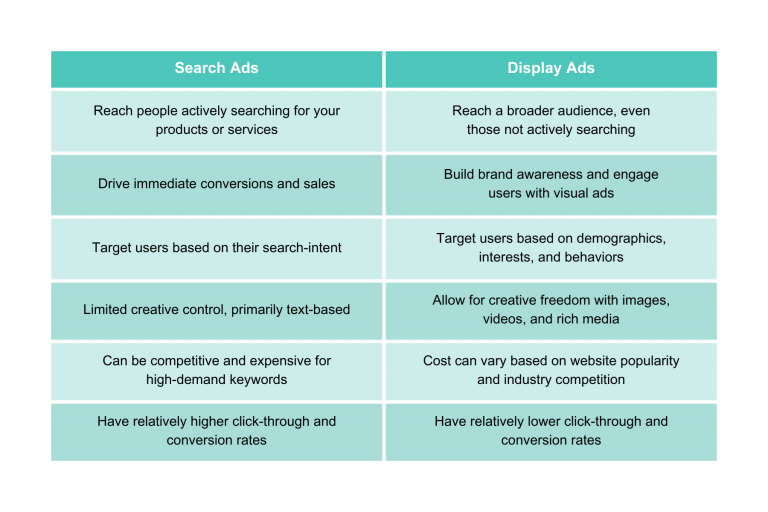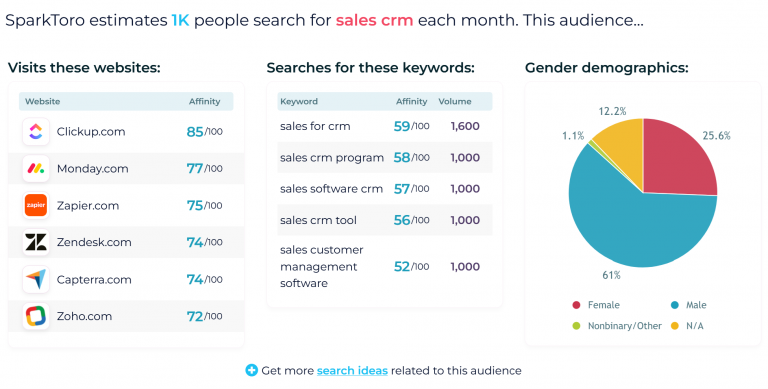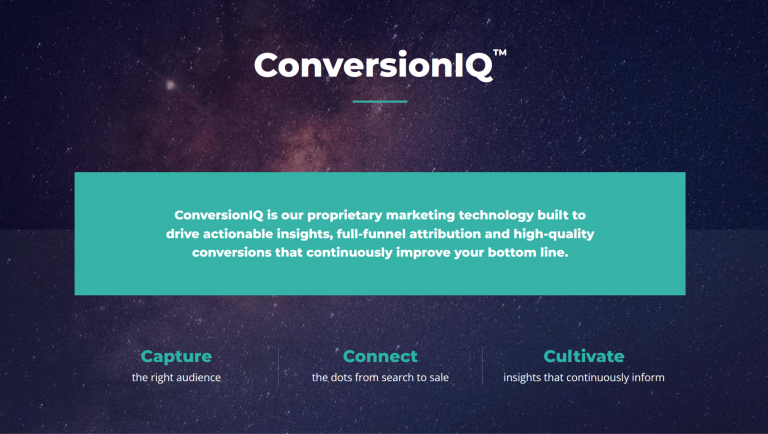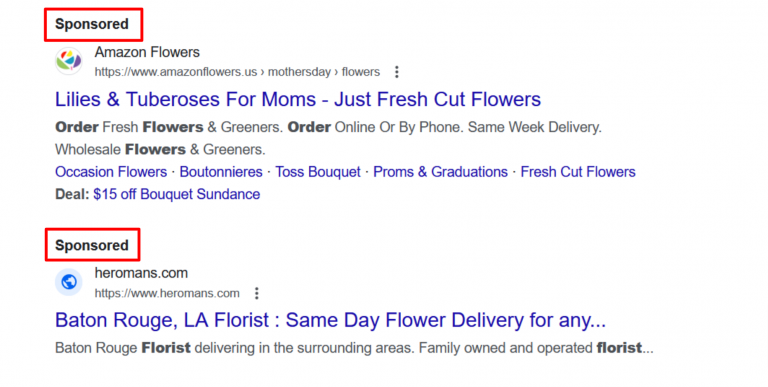Search ads reach people with high purchase intent. Display ads build brand awareness and attract potential customers not actively searching for your products. Learn when to use each (or both) to build awareness and clicks.
Here, you’ll find:
- How do search ads work?
- How do display ads work?
- Search ads vs. display ads: Which is better?
- Use cases: When should you use search ads and display ads?
- How to use search and display ads together
You’re ready to pay for online ads to generate more leads and sales, but you came across the display ad vs. search ad conversations, and now you’re confused.
Which one’s right for you? Which ad strategy will deliver better results?
That’s what we’ll answer in this article.
Let’s start with the basics of the search vs. display ads comparison.
How do search ads work?
Let’s say you decide to promote your Seattle-based coffee shop. You start by picking keywords related to your business, like “Seattle coffee shop” or “best espresso in Seattle.”
Then, you create an ad with a catchy headline, a compelling description of your coffee shop, and a link to your website. Responsive search ads allow you to create multiple headlines and descriptions, which the ad platform will automatically test and optimize for the best performance.
Next, you bid on these keywords. Meaning, you tell the search engine how much you’re willing to pay every time a user clicks on your ad.
But here’s the catch: Winning the top spot isn’t just about how much you pay.
The search engine also assesses how relevant and useful your ad is to the searcher. For instance, Google uses metrics like Quality Score for this. Similarly, ad strength in Google Ads shows how relevant and useful your ads are to users, which can impact your ad’s visibility and performance.
Further reading: Paid Search Optimizations: The Quick-and-Dirty Guide
How do display ads work?
When you set up a display campaign, you define your target audience’s characteristics, such as their interests and demographics.
Next, you:
- Design your ad creatives
- Set your budget
- Bid for ad placement
Once your campaign is live, the ad network uses your targeting parameters to place your ads on relevant websites and apps.
For example, if you’re selling fitness gear, your ads may appear on health and workout websites visited by fitness enthusiasts.
This contextual targeting in Google Ads and other advertising platforms allows you to place your display ads on websites relevant to your products — even if they don’t contain your exact keywords.
Further reading: 10 Display Ads Best Practices
Search ads vs. display ads: Which is better?
Choosing between a search ad vs. display ad depends on your marketing objectives, budget, and target audience.
Here are the pros and cons of each to show the main differences so you can determine what’s best for your advertising strategy:
Pros of search ads
- High-intent reach: Search ads place your business in front of people actively looking for your products. This high level of intent means they’re more likely to purchase.
- Immediate results: Because you’re reaching users ready to act, search ads can quickly drive conversions and sales. They offer a higher return on your investment.
- Optimization insights: With access to detailed metrics like click-through rates (CTRs) and conversion rates, you can fine-tune your search campaigns to improve their performance over time.
- Cost-effective targeting: You control your spending by setting ad budgets and bids. This allows you to efficiently use your marketing dollars to reach interested users.
Cons of search ads
- Creative limits: Search ads primarily rely on text, which gives you less room to use creative visuals or branding than other ad formats.
- Keyword competition: Popular search terms can have high cost-per-click (CPC) value due to high demand, potentially making competing for top ad positions expensive.
- Continuous optimization: To stay ahead, you’ll need to regularly adjust your bids, keywords, and ad copy. This can be time-consuming and even challenging for beginners.
- Search-dependent reach: Your ads only appear when specific keywords are searched. This limits your visibility to those already aware of their need for products like yours.
Pros of display ads
- Brand awareness: Display ads introduce your brand to a broader audience. This makes potential customers aware of your products even before they start searching.
- Visual engagement: With the freedom to use images, videos, and rich media, display ads can be designed to catch instant attention and engage users more effectively than text-based ads.
- Retargeting efficiency: Display advertising brings visitors back to your website. They nudge them towards conversion with reminders of what they viewed or interacted with.
- Advanced targeting: Beyond demographics, you can reach users based on various targeting parameters, like their interests, behaviors, and even specific websites they visit.
- Creative freedom: The versatile formats of display ads allow for more creative expression. It helps your brand and message stand out and resonate.
Cons of display ads
- Banner blindness: The commonality of display ads can lead to users subconsciously ignoring them, reducing their effectiveness.
- Lower direct engagement: Since display ads are often seen by users not actively seeking your products, they typically achieve lower click-through and conversion rates than search ads.
- Cost variability: Displaying ads on popular or highly relevant sites can be costly, especially in competitive industries or peak traffic times.

Use cases: When should you use search ads and display ads?
Search and display ads cater to specific needs and requirements. When deciding which type of advertising to use, You should consider factors, such as your business model (e.g., ecommerce), the sales cycle, and the specific targeting options available.
To get a quick start, here are different use cases for each:
- Launching a new product
- Promoting limited-time offers
- Building long-term brand awareness
- Targeting a niche audience
- Capturing high-intent traffic
- Re-engaging past site visitors
Launching a new product
Ideal ad type: Display ads
Display ads can make your potential customers aware of your new product even before they need it.
These ads visually showcase your product on relevant sites where your specific audience already spends time online.
For instance, if you’re launching a fitness tracker, display ads can feature it on health and wellness sites, showing its unique features through engaging visuals.
This captures attention and sparks interest among viewers who might not have known they wanted such a product.
Promoting limited-time offers
Ideal ad type: Search ads
Search engine advertising provides the immediacy you need for time-based promotions (e.g., a 24-hour sale or seasonal discount).
They target users who are already searching for products or deals like yours.
You can strategically use keywords related to your offer to show your ad in search results when potential customers are ready to buy. This makes your offer highly relevant and timely.
For example, advertising a “Black Friday electronics sale” will attract users searching for holiday deals on gadgets. Given their existing intent to purchase, it’ll drive targeted traffic that’s likely to convert.
Building long-term brand awareness
Ideal ad type: Display ads
Creating a lasting brand presence requires consistent visibility across the web. Display ads achieve this by placing your brand on various online platforms.
They help you reach audiences beyond those searching for specific keywords.
This continuous exposure builds familiarity. It ensures potential customers encounter your brand repeatedly, which is essential for long-term recall and recognition.
For example, let’s say you have an eco-friendly clothing line. Display ads can visually highlight your commitment to sustainability on related environmental sites, embedding your brand values in the audience’s consciousness.
This widespread visibility across the web helps establish a broad awareness of your brand and lays the foundation for future engagement.
Targeting a niche audience
Ideal ad type: Display ads
Display ads allow for precise targeting, ensuring focused advertising efforts. This helps when your product caters to a particular audience segment or appeals to niche markets.
For example, if your product is a premium yoga mat designed for serious practitioners, display ads enable you to target websites and content frequented by yoga enthusiasts.
Such targeting goes beyond simple demographics. It allows for behavior and interest-based targeting.
This makes your ads more relevant, improving the chances of engagement and conversion.
Capturing high-intent traffic
Ideal ad type: Search ads
When users have a clear and immediate need, they turn to search engines for solutions. This is where search ads emerge as highly effective in reaching users when they’re ready to make a decision.
Whether they’re looking for emergency services or ready to purchase a specific product, search ads ensure your offer is front and center.
You position yourself as the answer to their immediate need by targeting specific keywords related to your product.
Re-engaging past site visitors
Ideal ad type: Display ads
Retargeting past site visitors who didn’t make a purchase keeps your products and brand in their consideration set.
Display ads are particularly effective to show tailored ads to your audience based on previous interactions with your site.
For example, say a visitor looked at a particular pair of shoes on your site but left without purchasing. You can use display ads to show those shoes as they browse web pages on third-party sites.
This personalized reminder encourages them to revisit your site and complete their purchase.
“Search and display ads work best when used together. They complement each other, targeting potential customers at different stages of the buying journey,” said Rambod Yadegar, President of HawkSEM.
“Search ads excel at capturing bottom-of-the-funnel leads — people actively looking to make a purchase. But to get the most out of your search ad spend, you also need to run display ads. The most effective approach is a coordinated strategy that leverages the strengths of both ad types to guide customers from initial interest to final purchase.”
Further reading: 9 Expert Tips to Optimize Google Ads for Maximum Success
How to use search and display ads together
Creating an integrated campaign that combines search ads and display ads (and even other forms of PPC advertising) will drive better returns, rather than picking one after the display ad vs. search ad discussion.
Here’s how to use both types of ads together:
- Define your overall marketing goals
- Identify your target audience
- Prepare a cohesive messaging strategy
- Use display ads for broad targeting and awareness
- Capitalize on search ads for high-intent traffic
- Retarget with display ads
- Measure and adjust
1. Define your overall marketing goals
Start by outlining what you want to achieve.
Is it brand awareness, lead generation, or direct sales?
Your goal dictates how you’ll balance search vs. display ads.
For example, if building brand awareness is the goal, you may lean more toward display ads but use search ads to capture the interest generated.
PPC and content marketing can work together effectively — with display ads promoting your content and driving traffic, while search ads capture those actively searching for your products.
2. Identify your target audience
Knowing who you’re targeting is important to tailor your campaigns.
Use market research to create audience personas. For instance, if your audience is tech-savvy millennials, consider where they spend their time online and what they search for.
This information will guide where you place display ads and the keywords you choose for search ads.
You can use tools like SparkToro to enrich your audience personas.

3. Prepare a cohesive messaging strategy
Your ads should tell a consistent story. If display ads can build interest in a new product, search ads can capture that interest when potential customers look for more information.
For example, a display ad for a coffee machine on cooking blogs should match the messaging of search ads that appear for “latest coffee machines.”
4. Use display ads for broad targeting and awareness
Launch display ads to build awareness and interest across a wide audience.
Place these ads on sites relevant to your product and audience.
For example, if selling eco-friendly water bottles, target display ads on outdoor and environmental sites.
This wide net hooks the attention of potential customers who might not be actively searching yet.
5. Capitalize on search ads for high-intent traffic
When people search for terms related to your product, you want your search ads to appear.
Using the eco-friendly water bottle example from above, bid on keywords like “eco-friendly water bottle” or “sustainable drinkware.”
Ensure your landing page experience in Google Ads is relevant and user-friendly to improve your ad’s performance and conversion rates.
These ads catch users when they’re ready to learn more or purchase.
Further reading: 16 PPC Ad Copy Examples That Convert (+ Templates & Checklist)
6. Retarget with display ads
Use display ads to retarget individuals who clicked on your search ads but didn’t convert.
Showing targeted display ads based on their interactions with your site will emind them of their interest.
For example, while reading a fitness blog, someone who clicked on a search ad for “summer running shoes” but didn’t buy may see a display ad for the same shoes.
7. Measure and adjust
Finally, closely monitor the performance of both ad types. Use analytics and PPC tracking to understand which ads drive traffic, generate high-quality leads, or convert sales.
Adjust your strategy based on this data. Maybe shift more of the budget to search ads for high-converting keywords. Or tweak display ad placements to better align with your audience’s online behavior.
Google Ads auto-apply recommendations can help you optimize your campaigns based on best practices and machine learning insights.
At HawkSEM, we use ConversionIQ, our proprietary marketing tool that helps us track every step of the buyer journey.

It provides a centralized dashboard with granular insights into which parts of the campaigns work and which need improvement. We also leverage AI for PPC to optimize campaigns and improve performance.
All our clients get free access to ConversionIQ. Get in touch with us to know more.
What are search ads?
Search ads are paid ads that appear on search engine results pages (SERPs) when someone searches for keywords businesses bid on in ad campaigns.
Unlike SEO, which focuses on improving your website’s ranking in organic search results, search ads involve paying for top spots on the SERP, giving you immediate visibility.
These text ads are a part of the search network, which includes Google, Bing, and other search engines. They’re labeled as “Sponsored” or “Ad” and can appear at the top and/or bottom of the search result pages.
Here’s an example of a Google search ad:

Search advertising works on a pay-per-click (PPC) model. You pay each time someone clicks your ad. This is why they’re also referred to as PPC ads.
What are display ads?
Display ads are visual advertisements placed on third-party websites and apps, including news sites, blogs, and social media platforms.
They can be static images, video ads, or interactive ads that hook users to click through to a landing page.
Here’s an example of a display banner ad on The New York Times website:

Display ads typically operate on a cost-per-thousand-impressions (CPM) model, where you pay a fixed amount for every 1,000 ad views.
They’re served through ad networks like Google Display Network (GDN). Ad networks connect advertisers with publishers (websites and apps that want to host advertisements).
You can use display ads to target users based on their online behavior, interests, and demographics. This allows you to engage a broader audience across the web and not just through search queries.
Further reading: All Google Ad Sizes, Examples That Perform + Expert Advice
The takeaway
End the display vs. search ads comparison. Both have their strengths. The key is to use them together to build an integrated strategy that guides potential customers through the marketing funnel.
If you need help, talk to our ad experts.
HawkSEM is a leading digital marketing agency that works with the biggest brands like Microsoft, Nike, Honda, and Direct TV.
We offer end-to-end online ad solutions, empowering clients to achieve all-round growth.
For instance, Radar, a leading location data infrastructure provider, saw a boost in paid search website traffic by 42% and lead volume by 68%. Our team helped it increase pipeline opportunities by 125%.
“Our team’s extensive experience managing ad campaigns across various industries gives us a unique perspective on what works and what doesn’t,” said Yadegar.
“We don’t rely on generic best practices. We research each client’s needs and create tailored strategies that maximize their ROI. Whether combining search and display ads for a full-funnel approach or leveraging advanced targeting techniques, we’re always looking for ways to help our clients outperform their competition.”
Book your free consultation today to discuss your digital advertising needs.




